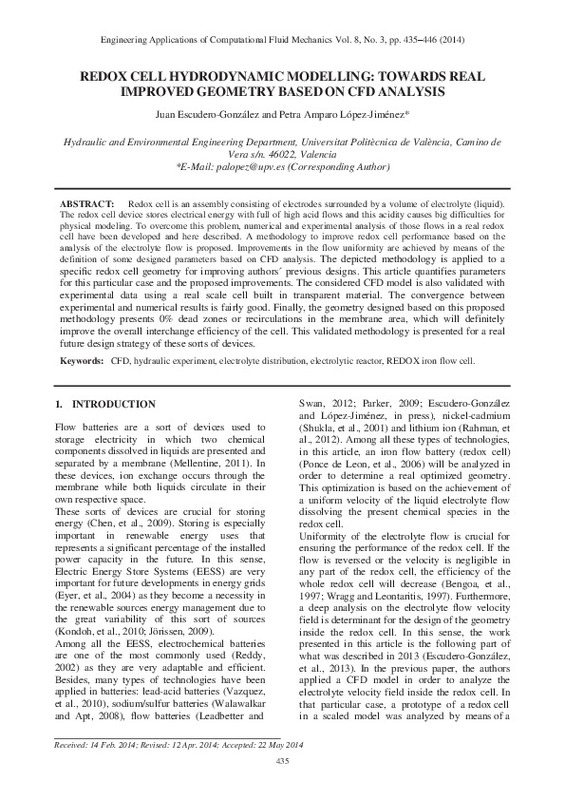Bannari A, Cirtiu C, Kerdouss F, Proulx P, Menard H (2006). Turbulence intensity in an electrochemical cell: effect on reactor performance.Chemical Engineering and Processing: Process Intensification45:471–480.
Bard A, Faulkner L (2001).Electrochemical Methods. Wiley.
Castelain C, Mokrani A, Legentilhomme P, Peerhossaini H (1997). Residence time distribution in twisted pipe flows: helically coiled system and chaotic system.Experiments in Fluids22(5):359–368.
[+]
Bannari A, Cirtiu C, Kerdouss F, Proulx P, Menard H (2006). Turbulence intensity in an electrochemical cell: effect on reactor performance.Chemical Engineering and Processing: Process Intensification45:471–480.
Bard A, Faulkner L (2001).Electrochemical Methods. Wiley.
Castelain C, Mokrani A, Legentilhomme P, Peerhossaini H (1997). Residence time distribution in twisted pipe flows: helically coiled system and chaotic system.Experiments in Fluids22(5):359–368.
Cebeci T, Bradshaw P (1977).Momentum Transfer in Boundary Layers. McGraw-Hill.
Chen H, Ngoc-Cong T, Yang W, Tan C, Li Y, Ding Y; Chen, H; Ngoc-Cong, T (2009) Progress in electrical energy storage system: a critical review.Progress in Natural Science19(3):291–312.
CD-Adapco. (2013).User Guide STAR-CCM+. Version 8.06. © 2013
Codina G (1992).Desarrollo de una Planta de Acumulación de Energía Eléctrica Basada en el Acumulador Redox Fe/Cr. Thesis. Universidad de Alicante,
Demirdzic I, Muzaferija S (1995). Numerical method for coupled Fluid Flow heat transfer and stress analysis using unstructured moving meshes with cells of arbitrary topology.Computer Methods in Applied Mechanics and Engineering125:232–255.
Escudero-González J, Alberola A, López-Jiménez P (2013). Redox cell hydrodynamic modelling, simulation and experimental validation.Engineering Applications of Computational Fluid Mechanics7(2):168–181.
Escudero-González, J., & López-Jiménez, P. A. (2014). Iron redox battery as electrical energy storage system in the Spanish energetic framework. International Journal of Electrical Power & Energy Systems, 61, 421-428. doi:10.1016/j.ijepes.2014.03.067
Eyer, James M, Corey, Garth P, Iannucci, Joseph J (2004). Sponsoring Organization: USDOE 2004.
Frias-Ferrer A (2004).Optimización de la Hidrodinámica de Reactores Electroquímicos:Empleo de Métodos Experimentales y Numéricos. Thesis. Universidad de Alicante.
Jörissen L, Frey H (2009). ENERGY | Energy storage.Encyclopedia of Electrochemical Power Sources215–231.
Kondoh J, Ishii I, Yamaguchi H, Murata A, Otani K, Sakuta K, Higuchi N, Sekine S, Kamimoto M (2010). Electrical energy storage systems for energy networks.Energy Conversion and Management41:1863–1874.
Mellentine J (2011).Performance Characterization and Cost Assessment of an Iron Hybrid Flow Battery. Thesis. University of Iceland.
Moore S, David (2003).The Basic Practice of Statistics, 3rd Edition. New York: W,H, Freeman and Company.
Navidi W (2006).Estadística Para Ingenieros y Científicos, 1st Edition. New York: McGraw-Hill Companies Inc.
Parker C (2009). APPLICATIONS – STATIONARY | Energy storage systems: batteries.Encyclopedia of Electrochemical Power Sources53–64.
Rahman F, Rehman S, Abdul-Majeed M (2012). Overview of energy storage systems for storing electricity from renewable energy sources in Saudi Arabia.Renewable and Sustainable Energy Reviews16:274–283.
Reddy T (2002).Linden’s Handbook of Batteries, 3rd Edition. McGraw-Hill Professional,
Scamman D, Reade G, Roberts E (2009). Numerical modelling of a bromide–polysulphide redox flow battery: part 1: modelling approach and validation for a pilot-scale.Jounal of Power Sources189:1220–1230.
Shih TH, Liou WW, Shabbir A, Yang Z, Zhu J (1994). A new k-ɛ eddy viscosity model for hight Reynolds number turbulent flows - model developmente and validation.NASA TM106721.
Shukla A, Venugopalan S, Hariprakash B (2001). Nickel-based rechargeable batteries.Jounal Power Sources100:122–148.
Vazquez S, Lukic SM, Galvan E, Franquelo LG, Carrasco JM (2010). Energy storage systems for transport and grid applications.IEEE Transactions on Industrial Electronics57(12):3881–3895.
Walawalkar R, Apt J (2008).Market Analysis of Emerging Electric Energy Storage System. DOE/NETL-2008/1330.
[-]









